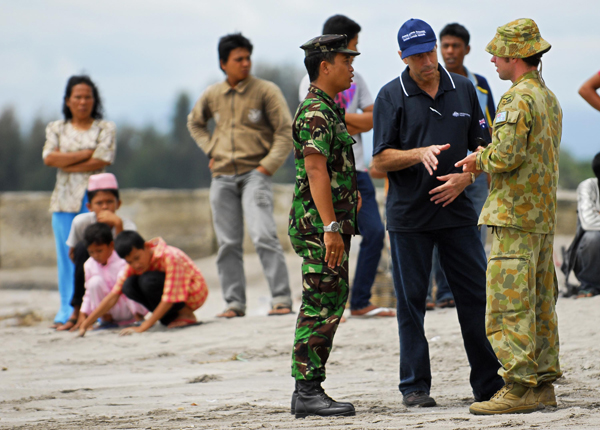The ADF has done a lot to harmonise its capability to fulfil military objectives. But government must think beyond the ADF when looking at how we will prepare an amphibious capability that will fulfil national objectives. There’s a gap here: other government agencies and the humanitarian sector need to be brought into ADF planning. That’s because HADR is growing in importance as a national priority in our disaster-exposed region.
The latest super typhoon to hit the Philippines again reminds us of the human toll caused by nature’s fury. Already the US, UK and Canadian militaries are assisting in relief efforts and an Australian medical team transported by a C17 departs today. The scale of these natural disasters is likely to increase due to a combination of population growth, coastal development, higher population densities and climate change.
The Australian military has been a contributor to regional disaster response: over the last over the past 21 years, the ADF has been involved in 30 offshore disaster response missions (p. 24), or an average 1.5 missions per year. Their use varies depending on both demand and supply issues. But the ADF’s HADR capabilities are about to be massively expanded with introduction of the LHDs: each ship can carry a combined armed battle group of more than 1100 personnel, 100 armoured vehicles and 12 helicopters and a 40-bed hospital.
A recent RAND report (PDF) points to some lessons that the ADF could consider in the use of the LHDs (discussed recently on The Strategist), especially the importance of personal connections between individuals and developing exercises that focus on joint planning between the defence and NGOs.
The ADF needs to embrace a new public–private disaster response model. Defence should deploy the LHDs on disaster missions using a combination of public agencies such as health and aid officials, the private sector, including engineering and logistics companies, and NGOs.
Each brings a capability that is unique and allows for the ADF to play a supporting and facilitating role (based on its strengths in planning and logistics). Defence should leave the delivery of the response to others, with the exception of specialist capabilities not held by other parties.
NGOs aren’t always good at making medium-term commitments to contingency planning for a range of reasons to do with budgets and often competition with other groups. But this’ll be important if these HADR operations are going to work. They need to be able to provide a given number of qualified and trained people in a given location, with agreed equipment and training, all at an appropriate notice to move.
The benefit of the load sharing nature of public–private disaster response model is that the ADF can extract itself quickly when alternative logistic and administrative arrangements come on line. For this to occur, a considerable effort is required to plan, train and exercise jointly. Standard multi-week exercises aren’t practical for the private sector and NGOs. Instead there needs to be short-focused exercises.
SOPs need to be developed and agreed upon to allow non-military personnel to operate from the vessels. Doctrine needs to be developed in conjunction with other government and non-government groups.
A matrix of response packages based on location/scale and nature of the disaster could be developed. In the event of a tsunami in northern PNG, for example, you could pull out a pre-agreed generic plan and rapidly tailor it for the actual circumstances, including available ADF and other public agency capabilities, as well as private and NGO capabilities.
But who pays to be at such readiness? There’d be pressure on the Australian government to provide some support in exchange for the commitment by the private and NGO sectors as part of our aid program.
There also needs to be much better integration between disaster response activities and pre-existing aid development activities. The LHDs, with their enormous capability can lift sufficient plant equipment to come in and rebuild large infrastructure quickly, and carry the medical support needed to treat whole communities rapidly. (It’s important to note here, however, that Defence’s integral capability is thin: it needs civil assets and private sector resources to be meaningful.)
While this is a great for immediate recovery, it can undermine the economy of the community as locals don’t get employment building infrastructure, and possibly adversely impact on local medical services.
The potential is there though for an LHD to be a sea base: it could anchor offshore, and so not put additional pressure on facilities or local resources. It would also reduce some of the security and health risks to ADF personnel.
The use of the LHD capabilities needs to balance benefits and costs over both the long and short term. This can be achieved by integrating aid professionals and private sector engineering companies into the disaster response LHD teams. These groups will provide a warning about the need to bring local communities with them and integrate skilled and unskilled labour from the affected communities into their work plans.
The private sector and NGO organisations will need contracts and payment to maintain capabilities. This will be mostly in the form of time for people to train and exercise. Someone has to pay for this: it isn’t a free lunch.
Anthony Bergin is the deputy director at ASPI. Athol Yates is an assistant professor, Institute for International and Civil Security, Khalifa University of Science, Technology & Research, Abu Dhabi, UAE. They are the co-authors of More than good deeds: Disaster risk management and Australian, Japanese and US Defence forces, ASPI Special Report. Image courtesy of Department of Defence.


